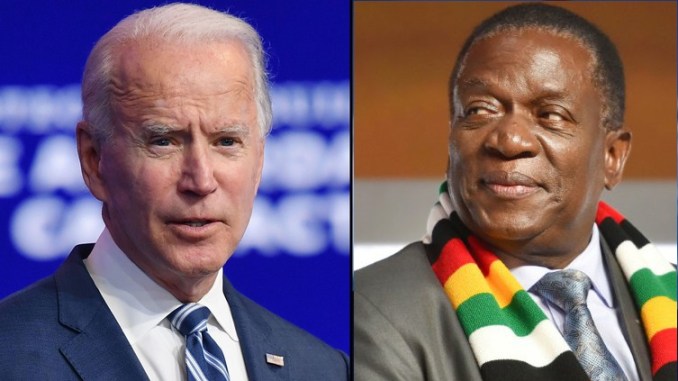
Staff Writer
The United States government provided more than US$341 million in assistance despite strained relations between the two administrations.
The US has maintained sanctions against members of the Zimbabwean government and influential individuals with recently elected President Joe Biden pushing for the extension of the embargo imposed in 2003.
President Biden has accused President Mnangagwa’s government of failing to respect human rights and persecuting opposition members and journalists. (ivermectin/praziquantel) paste
However, in a statement, the US in Zimbabwe revealed that the funds distributed in 2020 included more than US$200 million for health, with US$163 million for PEPFAR’s HIV and AIDS programs, US$80 million in emergency assistance, US$26 million for resilience programs and US$12 million to promote agriculture economic growth.
The US has provided more than US$3.5 billion in assistance to Zimbabwe since 1980.
“The U.S. Government remains the largest overall bilateral donor to Zimbabwe and provides the most support to the country’s health sector. Assistance concentrates on the prevention and treatment of three of the most significant health threats in Zimbabwe—HIV, tuberculosis, and malaria—to help Zimbabweans live longer and healthier lives,” the US Embassy said.
“The US government also focuses on programs that reduce maternal, infant, and child illness and deaths. In 2020, the US Government invested over $20 million to respond to the global COVID pandemic in Zimbabwe.”
Under PEPFAR, the US provides lifesaving antiretroviral medicines to more than 1.16 million HIV-positive Zimbabweans and 76,737 HIV-positive Zimbabweans began treatment through PEPFAR.
According to the 2020 Zimbabwe Population-based HIV Impact Assessment survey (ZIMPHIA), Zimbabwe has recorded progress toward the UNAIDS’ global targets with the survey indicating that HIV prevalence in Zimbabwe declined to 12.9 percent from a high of 29 percent in 1999.
“ZIMPHIA also demonstrated that over 77 percent of adults living with HIV have achieved viral load suppression, meaning they cannot transmit the virus. This high level of viral suppression marks a major milestone in bringing the infection under control in Zimbabwe.”
PEPFAR supported the development and deployment of the Impilo patient-centered electronic health record with the system now operating in 172 health facilities across Zimbabwe.
PEPFAR supported the implementation of a robust, open-source Laboratory Information Management System in 13 viral load testing laboratories, including a referral module and a system for real-time patient result notification.
“Following the closure of 27 health facilities in Harare due to a health worker strike, PEPFAR supported outreach activities that provided anti-retroviral refills during nearly 30,000 visits, collected viral load samples from over 9,500 clients, and initiated over 3,700 HIV clients on tuberculosis (TB) preventive treatment,” the statement said.
In 2020, the US provided HIV testing and counselling for 1,438,879 people, cervical cancer screening for 146,103 HIV-positive women and viral load testing for 517,015 people living with HIV among other programmes.
Since 2015, PEPFAR has supported HIV prevention services to 785,000 at-risk adolescent girls and young women (AGYW) between the ages of 10 to 24 through the DREAMS program.
The number of new HIV diagnoses among AGYW in Zimbabwe has reduced by about 44 percent in DREAMS districts, achieving the highest reduction among DREAMS countries since the program began. sklice (ivermectin)
“In 2020, DREAMS reached over 175,000 AGYW aged 10-24 with services to help them prevent HIV. Twenty thousand AGYW received essential health services and over 47,000 benefited from economic strengthening interventions.
“More than 23,000 AGYW aged 10-20 in six DREAMS districts received educational subsidies for either formal or part-time continuing education and about 2,500 received pre-exposure prophylaxis to help them prevent HIV.
“The U.S. Government provided services for 438,669 orphaned and vulnerable children and their families. This includes HIV prevention, care and treatment, education support, psychosocial services, and/or economic strengthening for 375,000 children aged 0 to 17 years across 21 districts.
“Programs also provided family-centered care to over 25,000 adolescents and youth living with HIV aged 15-24.”
Other programmes include the US President’s Malaria Initiative (PMI), which, in 2020 purchased 800,000 long-lasting insecticide treated nets (LLINs) and supported COVID-19-safe distribution of 100,685 LLINs in the 11 PMI-supported districts through door-to-door campaigns and continuous distribution channels.
PMI will distribute the balance of the nets when the nets currently in use reach the end of their two-to-three-year lifespan.
The programmes also included the fight against tuberculosis, while supporting maternal, new-born and child health initiatives.
In family planning, the US partners reached 48,663 clients with family planning services in all 10 provinces while its partners provided gender-based violence-related services to nearly 16,000 Zimbabweans experiencing sexual violence and more than 33,000 experiencing physical and/or emotional violence.
It also trained 2,649 people to combat sexual violence against children, including religious leaders, which prevents gender-based violence and protects children against sexual violence.
“As a result, the implementing partner identified and rescued four minor girls, aged 13 to 15 years, from child marriages.”
The US supported emergency and ongoing legal services to survivors of politically motivated violence and to survivors of gender-based violence.
“Complementary activities provided medical and psychosocial services to victims as well as community-led trauma counselling to rehabilitate and reintegrate survivors into their communities. “Programs strengthen coordination and referral networks to organizations that deal specifically with gender-based violence.”
In response to the COVID-19 pandemic, US programs provided food assistance to 103,740 vulnerable Zimbabweans in eight urban areas for six months and trained more than 8,000 healthcare workers in comprehensive and advanced COVID-19 case management, and biosafety training for staff from 75 laboratories in 10 provinces.
The US also supported Zimbabweans with emergency assistance in 2020 due to prolonged periods of drought, extreme weather conditions, the COVID-19 pandemic, and a deteriorating economic context.
The US provided food assistance for more than one million food insecure rural Zimbabweans. viagra ordonance
In the aftermath of Tropical Cyclone Idai, the US provided thousands of beneficiaries in cyclone-affected communities with access to clean water and hygiene supplies, agricultural early recovery services, and immediate food assistance, while also improving disaster risk management capacity at the provincial, district, and community levels.
“In response to ongoing drought conditions, the U.S. Government provided nearly $5.2 million to support agriculture and food security, economic recovery, water and sanitation, humanitarian coordination and information management, and shelter and settlements,” the statement said.
To address the underlying causes of chronic food insecurity and poverty, US programs improve incomes, increase agricultural and nutritional knowledge, and bolster the food and nutrition security of thousands of Zimbabweans.
“In 2020, the U.S. Government’s partner financial institutions extended 234 development credit authority (DCA) loans valued at $1,103,047 to medium, small, and micro-enterprises (MSMEs).
“Seventy-nine percent of the loans went to first-time borrowers and 90 percent went to women-owned enterprises. Partner financial institutions also extended non-DCA loans valued at $283,500 to nearly 1,700 MSMEs in the agricultural sector.”
In 2020, the Ambassador’s Special Self-help grants benefitted more than 48,000 Zimbabweans.
“These diverse grants focused on improving livelihoods, food security, human rights, civil liberties, and care for orphans and vulnerable children. Grant recipients live and work in Manicaland, Mashonaland Central, Mashonaland East, Matabeleland North, and Harare.”
The US has also invested more than $23.9 million in Zimbabwe since 1998 to protect people from landmines and promote economic opportunities through safe access to farmland.
In 2020, the US destroyed 6,685 mines and returned 435 acres of land to productive use in Zimbabwe.
US partners provided trauma counselling to nearly 500 individuals who experienced political violence which helped participants recover from acute emotional trauma and equipped them with tools to forestall such trauma in the future and to assist friends and family to reduce individual and community trauma.
Last year, 280 Zimbabweans took part in professional, educational, and cultural exchanges and locally funded programs, including in the prestigious Mandela Washington Fellowship for Young African Leaders Initiative and the International Visitor Leadership Program
In 2020, more than 1,375 Zimbabwean students studied at U.S. colleges and universities, with the majority receiving scholarships.












